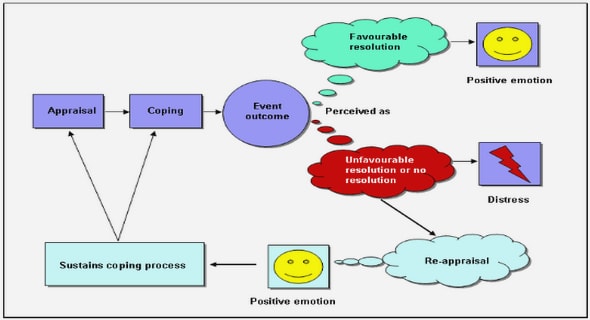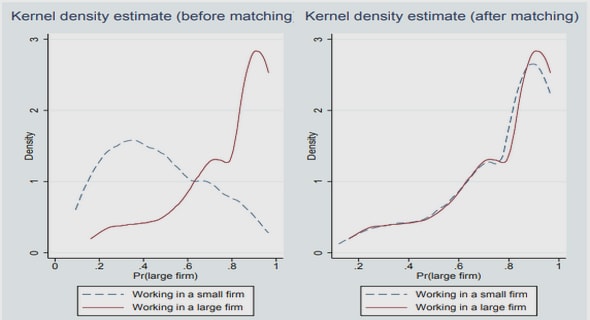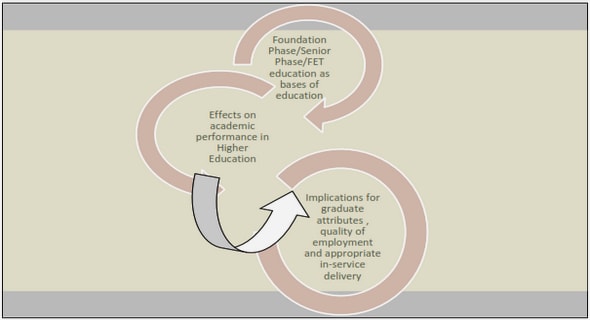Get Complete Project Material File(s) Now! »
Looking at a proton, second part
We go back to our proton (the same is true for a heavy ion, but to keep things simple only protons are drawn so far) of figure 2.2, but now consider it highly accelerated, as it is truly in the RHIC and LHC rings. It turns out that in this case, the picture given in figure 2.2 is too simplistic: it is in fact only valid when the proton is at rest. When the proton is moving at almost the speed of light, the picture is drastically changed. There are indeed other partons (a generic term regrouping the gluons and the quarks) that appear inside the proton. They are the sea quarks 3 and the gluons, which are the mediators of the strong interaction, as the photons are the mediators of the electromagnetic force. Why is it so? This is related to one of the most important principles in quantum theory called the Heisenberg uncertainty principle. What this principle essentially states is that it is not possible to know exactly at the same time the position and the speed of a particle, nor is it possible to know exactly its energy at a given time. This last uncertainty implies that on sufficiently small time scales – and in a heavy ion collisions, we are talking about a few times 10 24 seconds – the uncertainty on the energy triggers incredibly high fluctuations of its intensity at any point of space so that sometimes, the vacuum can acquire sufficiently high energy so that a pair of particles is created. This is called vacuum fluctuations, and is one of the explanation for such a rich content of a proton at high energy. Figure 2.7 illustrates the part of momentum which is carried by the different constituents of the protons in function of the momentum scale.
The quark-gluon-plasma: experimental evidences
When two heavy ions that look like figure 2.8 collide at very high energy, one can anticipate that the matter produced out of their collision is extremely complicated to describe. Indeed, gluons from one nucleus can interact with those from the other. The matter formed by this collision is called the Quark-Gluon-Plasma (QGP).
What are the evidences for this new form of matter? The best one is the observation in the experimental detectors of very energetic fluxes, corresponding to very located in space particles. The latter are called « jets ». The reasoning is the following: let’s assume for the time being that the QGP exists. In a heavy ion collision, as already mentioned, products are observed in the detectors of the RHIC and the LHC. But out of these products, some of them are much more energetic than others. Those are the result of the collisions of the most energetic objects in the nuclei – the collisions that imply the valence quarks for instance. When such collisions happen in the center of the QGP, one will usually observe two « back-to-back » jets, which means two very energetic beams of produced particles that cross both half of the QGP and then go hit the detector in opposite directions. Because those jets travel in opposite directions, they are correlated: the probability of finding the second jet at 180 degrees of the first one is very high. Now, consider again a very energetic collision, but happening this time at the edge of the QGP. In this situation one of the jet will only have to cross a tiny region of the QGP before escaping and hitting the detector, while the other has to cross most of the QGP. During this crossing, the jet will interact with the QGP and loose most of its energy 6. So if the QGP exists, one should sometimes observe in heavy ion collisions two correlated back-to-back jets, but with one being much more energetic than the other. Our expectation is illustrated in figure 2.10.
Quark-gluon-plasma: the puzzle
Theoretical models trying to describe this quark-gluon-plasma have been intensively de-veloped in the past twenty years. The conclusion of all these models is that the QGP should experienced an initial phase where it is very far from being at thermal equilibrium. If such an equilibrium was reached, it would imply some strong constraints for the QGP at both the macroscopic and microscopic level. At the macroscopic level, there should be a one to one relation between the energy density and the pressure of the system: a relation called equation of state (EOS). At the microscopic level, the distribution of the particles given their energy should be dictated by a specific function. This specific function, called the occupation num-ber (or distribution function) should follow a Bose-Einstein statistics for bosonic particles like gluons 9.
Meanwhile, other less fundamental theories such as macroscopic models have been used in order to try to reproduce the outcome of the collisions. The one that is best able to do so is relativistic hydrodynamics. This theory relies on the Navier-Stokes equations, that describe the motion of a relativistic fluid. It can be either ideal or viscous. It is a macroscopic theory as it describes the system with a very limited amount of parameters: the energy density of the fluid, its pressure and velocity. It turns out that relativistic hydrodynamics has been so successful in describing the outcome of the experiments that this is a puzzle for the heavy-ion community.
The issue is the following: in order for relativistic hydrodynamics to work, it requires some postulates, and one of the most important is a very rapid thermal equilibration 10 of the QGP. But as already mentioned, more fundamental theoretical models that adopt a microscopic description of the QGP fail to predict such a short thermalization time.
A lot of work has been done in order to try to understand why a short transition from an out-of-thermal equilibrium QGP (also called Glasma) to a thermalized QGP is possible. The holy grail of the field is therefore the understanding of the assumed to be fast transition illustrated in figure 2.14.
Hydrodynamics
As it name suggests, hydrodynamics is the theory that governs the motion of a fluid. This theory is macroscopic: it does not seek to describe fully a system at the microscopic level (like QCD would), but rather study a few macroscopic quantities: the energy density e, the pressure p, and the velocity of the fluid um, where from now on Greek letters stand for Lorentz indices that go from 0 (time dimension) to 3 (1, 2 and 3 being the spatial indices). This means 5 independent variables, since umum = 1. In order to determine these unknown quantities, one therefore needs five equations. If the fluid is ideal (meaning that it is not viscous), the laws that govern the fluid movements have been derived more than 250 years ago (in 1755 to be precise) by Leonhard Euler. There are the Euler equations. We will not repeat them here as we are more interested in the non-ideal case. Indeed, as we will see, the QGP is viscous 2.
Hydrodynamical simulations can reproduce the RHIC and LHC data
Since the start of RHIC, hydrodynamical simulations have managed to reproduce very successfully the outcome of heavy-ion collisions. Many works have been performed in this framework (see for instance [12, 14–21]), and we will only discuss here one of these stud-ies [13], that will serve our purpose later on: the large elliptic flow 9 observed in heavy-ion collisions. The measurement of the elliptic flow v2 is explained in [112] 10, and one can also understand there why the measured v2 is larger than one may naively expect. The numerical results obtained by Luzum and Romatschke in [13] are reproduced in figure 3.1
Strongly coupled techniques: fast « hydrodynamisation »
The strongly coupled techniques that are used in order to describe the early life of the out of equilibrium QGP rely on the AdS/CFT conjecture [116], illustrated in figure 3.2. This conjecture establishes a link between supersymmetric gauge theories (which QCD is not) and string theories in a five dimensional Anti de-Sitter curved space time. In the limit where the gauge coupling becomes infinite, the string theory reduces to general relativity, and one therefore just needs to solve Einstein’s equations to calculate the quantities of interest in the theory. This is what has been done in [29], where Einstein’s equations have been solved for various initial conditions. The results are reproduced in the figure 3.3.
We see that the out-of-equilibrium AdS/CFT calculations very rapidly coincide with the viscous hydrodynamical simulations. This is illustrated in the left plot (where w plays the role of the time t), where the agreement between the two theories is compatible with the t0 1 f m/c mentioned in the previous sections. The surprise comes from the right plot, where we see that this agreement already happens when the system is rather far from being isotropic. Does this means that the range of applicability of hydrodynamics is broader than we may expect given the postulates I IV0? More realistic initial conditions (colliding shock waves in the AdS space in order to mimic the heavy-ions) are currently investigated in order to answer in a more definitive way this question at strong coupling [34].
Another important result found within the AdS/CFT framework is the fact that hydrody-namics – as perturbation theories – is based on an asymptotic expansion [120]. The radius of convergence of the gradient expansion is in fact 0. This comparison between hydrodynamics and AdS/CFT techniques has been very fruitful. The AdS/CFT framework is an interesting playground to understand what is happening in heavy-ion collisions, but should not be con-sidered as more than a toy model. Indeed, the assumption that the QGP is infinitely strongly coupled seems extreme, as one can see on figure 2.3. At the scale Qs 1 2GeV, the strong coupling constant as is of the order of 0.3. In addition, QCD is pretty different from a super-symmetric gauge theory. This is what motivates our choice to stay within a weakly coupled description of the QGP in the remaining parts of this manuscript.
Table of contents :
Résumé
Abstract
Remerciements
1 Introduction
1.1 Understanding the effectiveness of hydrodynamics in heavy ion collisions
1.2 How to read this thesis?
I Theoretical background
2 The problem of thermalization in heavy-ion collisions
2.1 The strong interaction
2.2 Looking inside a proton, first part
2.3 Heavy Ion collisions
2.4 Looking at a proton, second part
2.5 The quark-gluon-plasma: experimental evidences
2.6 Has the QGP ever existed in the history of the universe?
2.7 Quark-gluon-plasma: the puzzle
3 Theoretical tools to deal with the Quark-Gluon-Plasma
3.1 Kinetic Theory
3.2 Hydrodynamics
3.3 Strongly coupled techniques: fast « hydrodynamisation »
3.4 Quantum Chromodynamics
3.5 Specificities of heavy-ion collisions
3.6 The Color Glass Condensate (CGC) effective theory
3.7 JIMWLK equation
3.8 LO CGC results: Impossible matching with hydrodynamics
3.9 NLO CGC results: Weibel instabilities and secular divergences
3.10 Summary
Appendices
3.A Bjorken’s law for an ideal fluid
4 Beyond standard perturbation theory
4.1 Schwinger-Keldysh formalism
4.2 Resummation formula
4.3 The Classical-statistical approximation: a path integral approach
4.A Relation between Schwinger-Keldysh and Feynman generating functionals
II Study of a scalar field theory
5 Scalar field theory in a fixed volume
5.1 Setup of the problem, specificities of the scalar model
5.2 The physics of instabilities
5.3 Macroscopic observables: the formation of an EOS
5.4 Microscopic properties of fixed volume scalar field theory
5.5 Summary
4 TABLE DES MATIÈRES
5.A Instabilities in the fixed-volume case
5.B Appendix: Effective Hamiltonian
6 Expanding system
6.1 Expanding scalar theory
6.2 Numerical implementation
6.3 Independence with respect to the initial time
6.4 Resonance band
6.5 Occupation Number
6.6 Energy-momentum tensor
6.7 Hydrodynamical behavior
6.8 Summary
6.A Numerical considerations
7 Non Renormalizability of the Classical Statistical Approximation
7.1 Renormalization of Green’s functions
7.2 Renormalization of composite operators
7.3 The retarded-advanced basis
7.4 Eliminating the source term
7.5 Ultraviolet power counting in the full theory
7.6 Ultraviolet power counting in the CSA
7.7 Ultraviolet divergences in the CSA
7.8 Impact of the non-renormalizability of the CSA on Tmn
7.9 Cumulative effects of the non-renormalizability
7.10 Possible partial cure
7.11 Could the cure be implemented numerically?
7.12 Summary
7.A Calculation of G1112 and G1222
7.B Calculation of G1122
III Yang-Mills theory
8 Spectrum of fluctuations above the light cone
8.1 Spectrum of fluctuations: a new derivation
8.2 Known results for the background field
8.3 The axial gauge
8.4 Going to Fock-Schwinger gauge
8.5 Small fluctuations in the forward light cone
8.6 Summary
8.A Useful formulas to derive (8.35)
8.B Several checks on the step 3
9 Numerical results
9.1 Numerical implementation of the Yang-Mills Equations
9.2 Matrix multiplication on the lattice
9.3 Leap-frog algorithm
9.4 Initial conditions for the background field
9.5 Discretized form of the energy-momentum tensor
9.6 Numerical checks
9.7 Initial conditions for the small fluctuations
9.8 Monte-Carlo: speed versus storage
9.9 Enforcing the non-linear Gauss’s law
9.10 Renormalization
9.11 Numerical results: isotropization, anomalous viscosity
9.12 Summary
10 Conclusion


